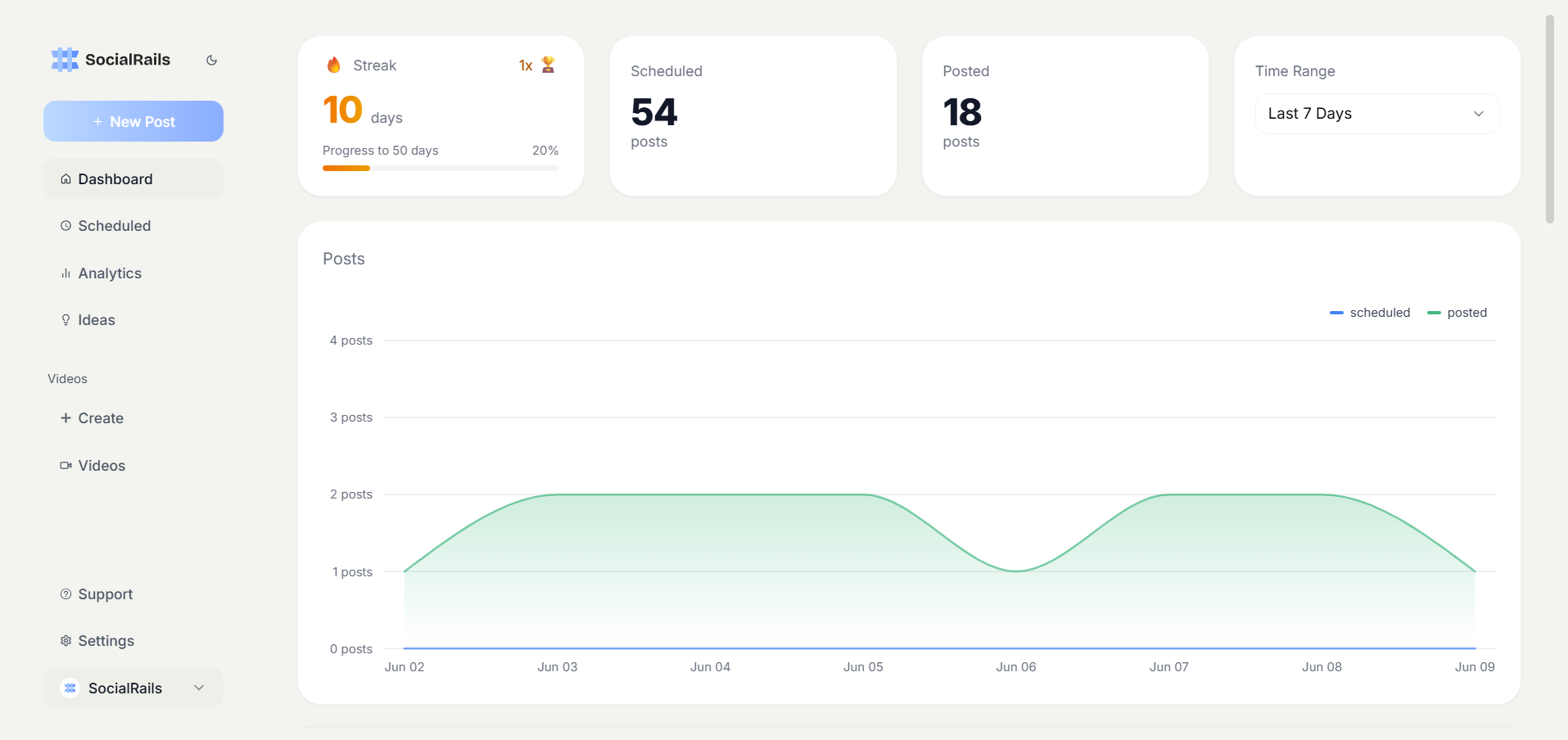Retention Rate Meaning
Retention rate measures the percentage of customers, followers, or users who remain engaged with your brand over a specific time period. It's a key indicator of customer satisfaction, product value, and long-term business success.
🤔 Quick Knowledge Check
What does a high retention rate indicate about your business?
Why retention rate matters
Create content, post everywhere
Let AI do the work. Ideas, posts, images, carousels. Scheduled in seconds.
Start your free trial
Cost-effective growth
Retaining existing customers typically costs significantly less than acquiring new ones, making retention rate a critical metric for sustainable business growth.
Predictable revenue
High retention rates create stable, recurring revenue streams that make business planning and forecasting more accurate and reliable.
Customer lifetime value
Better retention directly increases customer lifetime value (CLV), as loyal customers spend more and stay longer with your brand.
Competitive advantage
Strong retention rates indicate superior customer experience and product value compared to competitors who struggle to keep customers.
Types of retention rates
Customer retention rate
Measures the percentage of customers who continue purchasing from your business over a specific period.
Social media retention rate
Tracks how many followers remain engaged with your social media content over time without unfollowing.
App retention rate
Measures the percentage of app users who return and continue using your application after initial download.
Employee retention rate
Tracks the percentage of employees who remain with your company over a given time period.
How to calculate retention rate
Basic retention rate formula
Retention Rate = ((CE - CN) / CS) × 100
Where:
- CE = Customers at end of period
- CN = New customers acquired during period
- CS = Customers at start of period
Example calculation
If you started with 1,000 customers, gained 200 new customers, and ended with 1,100 customers:
Retention Rate = ((1,100 - 200) / 1,000) × 100 = 90%
This means you retained 90% of your original customers during the period.
| Category | Rate | Description |
|---|---|---|
| Excellent Retention | High | Top-performing businesses |
| Good Retention | Above Average | Strong performance |
| Average Retention | Moderate | Industry standard |
| Poor Retention | Low | Needs immediate attention |
Social media retention strategies
Create valuable content consistently
Regular, high-quality content keeps followers engaged and reduces the likelihood of unfollowing your accounts.
Build genuine relationships
Respond to comments, engage with followers' content, and show authentic interest in your community to strengthen loyalty.
Offer exclusive benefits
Provide special content, early access, or exclusive offers to social media followers to increase their perceived value.
Use data-driven insights
Analyze which content types, posting times, and topics generate the highest engagement rates to optimize retention.
Retention rate benchmarks by industry
Industry Retention Rate Benchmarks
SaaS
Typically high retention
E-commerce
Variable by niche
Retail
Moderate retention
Financial Services
Generally high retention
Media/Publishing
Varies by content type
Gaming
Depends on game type
How to improve retention rate
Improve customer experience
Focus on providing exceptional service at every touchpoint to increase satisfaction and loyalty among existing customers.
Implement feedback loops
Regularly collect and act on customer feedback to address issues before they lead to churn or disengagement.
Personalize interactions
Use customer data to deliver personalized experiences, content, and offers that match individual preferences and behaviors.
Create loyalty programs
Reward repeat customers with exclusive benefits, discounts, or recognition to incentivize continued engagement with your brand.
Measuring retention rate success
Set realistic benchmarks
Research industry standards and set achievable retention rate goals based on your business model and customer lifecycle.
Track cohort retention
Analyze retention rates for different customer segments or time periods to identify trends and optimization opportunities.
Monitor leading indicators
Track metrics like customer satisfaction scores, engagement metrics, and usage frequency that predict retention.
Calculate retention ROI
Measure the financial impact of retention improvements by tracking increased customer lifetime value and reduced acquisition costs.
Common retention rate mistakes
Focusing only on acquisition
Many businesses prioritize getting new customers while neglecting existing ones, leading to high churn rates and unsustainable growth.
Ignoring early warning signs
Failing to identify and address declining engagement or satisfaction before customers actually leave your business.
One-size-fits-all approach
Using the same retention strategies for all customer segments instead of tailoring approaches to different user behaviors and preferences.
Key takeaways
- Retention rate measures customer loyalty and indicates business health more than acquisition metrics alone
- Calculate retention accurately using the proper formula to exclude new customers from your retention calculations
- Industry benchmarks vary significantly so research standards specific to your business model and sector
- Focus on customer experience as the primary driver of improved retention rates across all channels
- Track retention by cohorts to identify trends and optimize strategies for different customer segments
- Measure retention ROI to justify investments in customer success and retention initiatives
Understanding and improving retention rate is essential for building a sustainable, profitable business. Focus on delivering consistent value to keep customers coming back rather than constantly chasing new acquisitions.
Ready to improve your retention rates? Start by tracking your current performance and implementing customer engagement strategies that build lasting relationships with your audience.